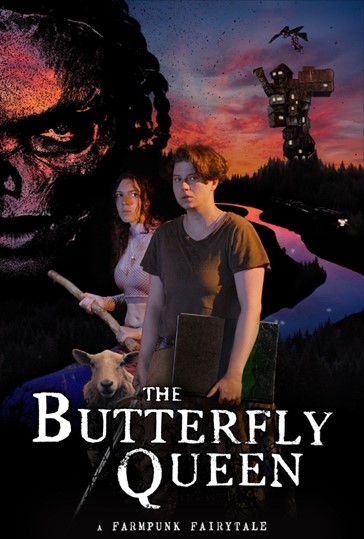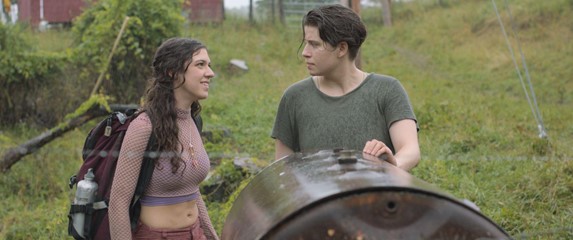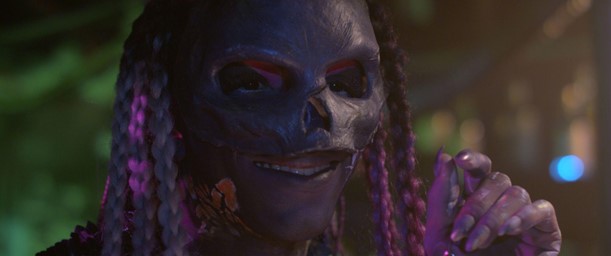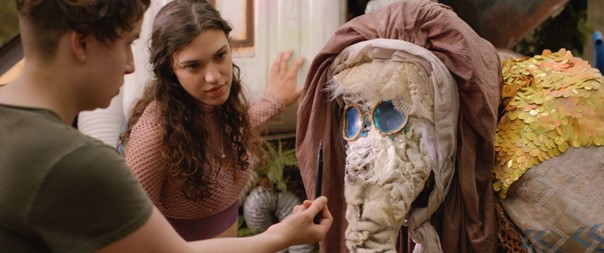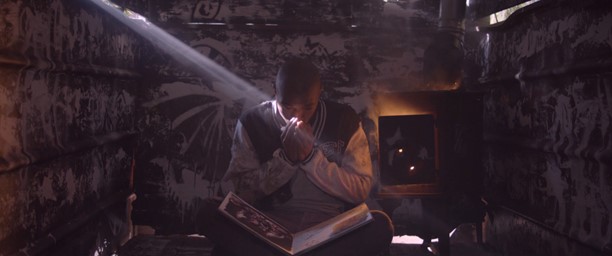Alexis Johnson: Please tell us about The Butterfly Queen in your own words.
Liam O’Connor-Genereaux (director): I wanted to tell a love story about friendship. Lots of movies focus on true “romantic” love (it’s one of the most celebrated forms of storytelling), but friendship, especially in cinema, is treated superficially. It’s either taken as a given and difficulties in the friendship are played for laughs—or it’s relegated to a B or C plot. For me, my platonic relationships are central to my life. They have been just as meaningful, difficult, and life-changing as falling in love. So I wanted to make a movie about that. In the woods. With monsters and portals and a dragon.
AJ: Your film emphasizes the importance of maintaining friendships and putting in the effort to keep them alive. Could you share any personal experiences or inspirations that contributed to the creation of this story?
LOG: The conversation that Casey (our struggling cartoonist protagonist) has with the local newspaper editor (Devon) is lifted from an actual conversation I had with a film curator/mentor in my own hometown. Just like Devon, he said that I had to go out to a big city to both make my art and make money at it. And I’m still trying to prove his advice wrong.
Taking a step back, the whole world of the story is deeply personal. Casey’s sheep farm was filmed on the farm of my upbringing, and the magical realm the characters explore is the same woods where I played as a child. There are scenes inspired by my imaginary adventures in specific parts of that forest, which we then brought to life in those exact spots. It was surreal.
AJ: Can you share insights into the casting process and how you ensured that the actors portraying close friends like Casey and Robin had genuine chemistry? Were there any specific approaches or considerations taken to capture the authenticity of their connection on screen?
LOG: I had worked with Kade Pintado, who plays Casey, on previous projects, and I approached them first to see if they wanted the role. I always liked how complete and filled with inner life they’re able to make a character, and I knew that would be crucial for our lead. Once Kade was on board, casting Robin was a multistep process. We put out a casting call on Backstage.com and had over two hundred submissions. From those, we asked for self-tapes, callbacks, interviews, and test reads with Kade, all the while narrowing it down until we found Sophia Anthony, whose Robin had just this amazing mix of cynicism and vulnerability. Then, it was a matter of getting Kade and Sophia to spend as much varied time together as possible, so they could develop a history.
Fortunately, we were able to have our first rehearsal together (also with Despoina, who plays The Queen) in person just before the pandemic hit. After that, I had Kade and Sophia tell each other childhood stories, play games, imagine Casey/Robin pranks, and talk through the characters over and over. With the pandemic, we delayed our shoot by a year, so by the time we were filming, Kade and Sophia had known each other for almost two (really significant) years. That depth of shared experience meant they could draw on a well of actual connection and not have to fake their close relationship on screen.
AJ: The film’s characters possess unique and visually striking appearances that reflect their personalities and roles within the story. Could you delve into how the costume and makeup designs were developed to align with each character’s traits and journey?
LOG: The goal was to express the characters’ intentions through their costumes. Casey’s costumes are very square and simple—Casey doesn’t plan to move. Meanwhile, Robin’s wardrobe has much more flow and is easy to move in because she never stops. Ash has bright colors at the beginning, which become bleached out later in the story as they become more trapped. The Queen’s outfit is bold, confident, and harsh, with spikes and more aggressive lines. Because this is a story about art having magical power, color was crucial. Each character has their own signature color and palette, and those colors apply to their props and environments as well, so that, subconsciously, the audience will feel like “Okay, this is a Casey space” or “Oh, this is The Queen’s world.”
Halina Vercessi (head of costumes, makeup, and hair): A lot of time and collaboration went into developing the costume designs. It was important to the art team to not only align visual appearance with the characters’ traits and reflect their journeys but also keep in mind that the audience only gets an hour and a half (or in some cases only brief moments) to get to know these characters. We emphasized making each character visually distinct and memorable no matter how much or little time the audience spent with them.
Robin wears interesting jewelry pieces and funky, but practical, secondhand pieces she probably picked up on her travels; Casey dresses purely for function in long-lasting, sturdy, and durable clothes that show that they’ve been worked in.
For the magical characters, we wanted the viewer to be left wondering what these interesting personalities do day-to-day and where they’ve been. They are unique, textured, layered, and so much to look at. In a way, they wear their stories and lives “on their sleeve.” Notably, the character of Ash is an exception to this and has a more dialed-down and quiet appearance. I’d say it’s almost like the other magical characters serve as a visual foil to Ash; Ash is part of the magical world but doesn’t necessarily belong. For The Queen, we wanted to strike a visual balance between being ready to jump into combat with a dragon (shown in her scale mail and armor) and dancing for an eternity in the nightclub (with her long, colorful hair, bold nails, and striking tattoos). She is bold, complex, and unabashedly herself (and also cool, she’s very cool).
AJ: The Butterfly Queen seamlessly blends elements of fantasy and reality. Could you share your insights into the process of crafting such an enchanting yet familiar environment?
LOG: The main thought process here was to plan the magic for what we had access to. The magical world the characters enter is created from the mind of a teenager who has never left their rural town, so we made sure to only use elements that would be available in such a place. Characters navigate through portals, which we created from anything that had an opening: suitcases, refrigerators, large pipes. Everything in the magical world is a weathered or sharpened version of a real-world element, with unnatural color added through bright paint and lights. We worked to make the magic the characters use feel visceral and intuitive, in the way that magic feels when you’re dreaming.
AJ: The film is full of fascinating set pieces, however, the one that caught my eye most of all is the Howl’s Moving Castle-esque building that contains Casey and Robin’s exit. Would you be able to guide us through the process of bringing this remarkable set piece to life and achieving such a realistic look?
Saskia Martinez (set designer and model builder): We drew inspiration from many different sources for The Queen’s Nightclub—everything from the magical worlds of Studio Ghibli (Howl’s Moving Castle and the bathhouse from Spirited Away) to fairy tales like Baba Yaga, to the wood, stone, and metal textures that we saw on buildings in Vermont. Most of the set piece is actually a model! In the shots that show the full exterior of the building, the only portion that was full-size is the stuff that actors interacted with—a platform on top of four wooden poles and the door underneath it. The model itself is about two and half feet tall and was built using both pre-fab model building materials (like quarter-inch scale stone walls) and materials like carved foam, paper towel tubes, wooden coffee stirrers, and cardboard (cut open so the corrugation can imitate corrugated metal). Creating a lot of rich texture and adding realistic wear and tear while painting helped ground the model in the world of the film.
AJ: You mentioned how much community involvement played a significant role in bringing this project to life. How did you rally the community around your film, and what impact did their support have on the final result?
LOG: This was a community event from the very beginning. I’ve been creating films in this area of Vermont since I was a little kid, so the line between crewmembers and friends became almost nonexistent with this project. People helped out with time, materials, and effort in so many ways: neighbors donated space in their homes for our out-of-town crew to stay during our five-week shoot; the local timberworks company donated lumber so we could build our sets; the local softball league let us film on their field under the lights; the local print shop ran all kinds of strange orders printing all the art you see in the film; the local mechanic built us a truck and then stunt drove it; a local farm took all our compost during the shoot; a local diner did our catering; local shops loaned us tools and workspaces, and dozens of friends came out to help build, paint, move, fix, lift and cajole. This film is a testament to the love and passion of an entire region, not just a film crew.
AJ: What do you hope audiences will take away from watching this film?
LOG: I hope you leave this film and go call your best friend. All my favorite movie-watching experiences have ended with me being inspired to go make a movie, so if you watch this and get inspired to go out and make something, I’d be overjoyed.
AJ: What’s next for you?
LOG: What is next, indeed! Something fantasy, that’s for sure. If you can make magic come true, why wouldn’t you? Seana (my producing partner) and I are planning a short or two before we do the next feature, so keep your eyes peeled and follow our socials and newsletter.
The Butterfly Queen is now available for screening! Watch it through this access link!
For a sneak peek, check out the trailer here.
Stay connected and keep up to date on The Butterfly Queen through their socials:
https://www.instagram.com/butterflyqfilm
https://www.facebook.com/butterflyqfilm
Author Biography
Alexis Johnson is a recent Film and International Studies graduate from the University of North Carolina Wilmington. She was fascinated by the intersection between cinema and cultural identity throughout her academic journey. However, she also possesses a passion for exploring film movements often overlooked in academia. Alexis hopes to delve further into these interests by one day acquiring a master’s degree.

